Birmingham City have spent quite a number of years in the EFL Championship already, rarely coming close to a promotion challenge. Jude Bellingham, the 16-year-old wonderkid, was a rare bright spark last season, and he earned a move to Borussia Dortmund in the summer window. Another key personnel change was in the dugout, where former Real Madrid defender Aitor Karanka took over the team and looked to implement his tactical philosophy.
With nearly half the season having passed, now is a good time to assess the state of this project. Sadly, things have not been too positive at the St Andrew’s Trillion Trophy Stadium as we saw BCFC earning just 23 points from 22 games, leaving them with only a four-point margin from the relegation zone. Even Karanka, a head coach who was once José Mourinho’s assistant, has not been able to fix the defensive issues of the team.
This tactical analysis summarizes why the defence of BCFC looked vulnerable up until the end of 2020, with some repeated issues and little evidence of sustained improvement.
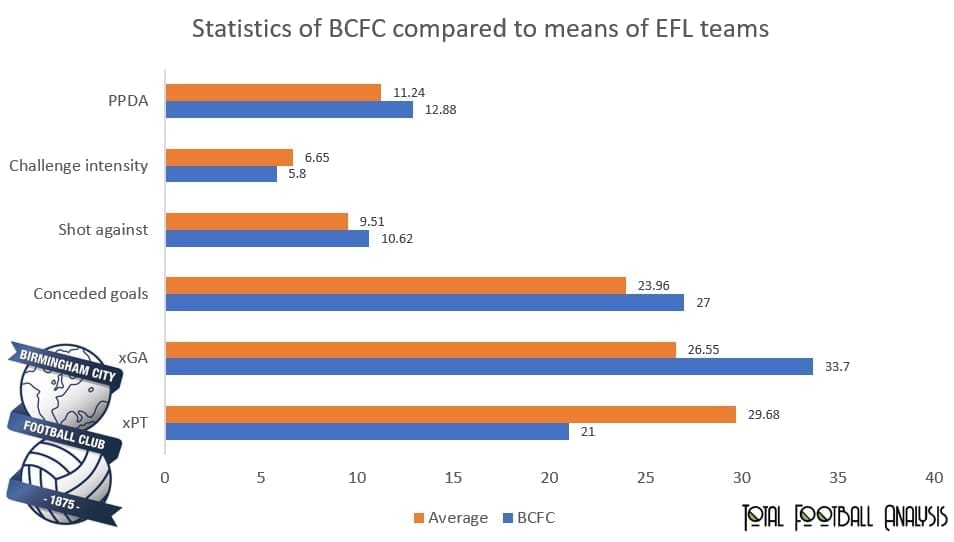
The bar chart shows a few key metrics for BCFC compared to other teams in the EFL Championship after 22 games.
In terms of PPDA – an indicator that shows the pressing intensity of a team, BCFC have averaged 12.88 which is slightly above the league average (11.24), showing that they are a fairly passive team this season. This is backed up by their numbers for challenge intensity (duels/tackles/interceptions per min of opposition possession) as well, where Birmingham have averaged 5.8 only, much lower than the mean (6.65) for the Championship, and it is the joint lowest among all 24 teams. While being a passive side out of possession is not an issue by itself, but, as we will see later, this can tend to create issues elsewhere.
BCFC have faced 10.62 shots per game, slightly higher than the league average at 9.51. This is not extremely poor considering some mid-table teams such as Preston North End and Bristol City have conceded more than Karanka’s men. The number of conceded goals is very good considering the team should have given away 33.7 according to xGA, which means that they are already overperforming from a defensive point of view. Credit should be given to the goalkeeper Neil Etheridge, who has been a big reason for this outperformance of xGA.
The cruel fact is that Birmingham was already doing a lot better than the expected metrics. At the time of writing, their xPts was 21,the lowest in the league and 8.68 below average. In reality, they had 23 points, showing how they were slightly better off than they should have been, and only staying out of the relegation zone due to even poorer performances from other teams. Thus, rapid improvement is needed in 2021 if the club is to survive this season.
Man-oriented high pressing at flanks
The analysis begins with a look at the high pressing of BCFC. This may not have been apparent when looking at PPDA and challenge intensity, but Karanka’s team press high in the first phase of play. In fact, this was the best area of their defensive work.
The first layer was formed by two players, who do not initiate the press until the trigger – a wide pass to the opposition full-back was made. A numerical deficit against teams playing a back three can be expected, so one of those two covers the pivot, while the other splits the centre-backs through his body orientation.
The first image in this section shows the features of the press. The 2 v 3 underload at the centre is clear, and the striker did not press, prioritizing the coverage of spaces behind him. The BCFC winger is ready to press wide once the pass is played out to the full-back.
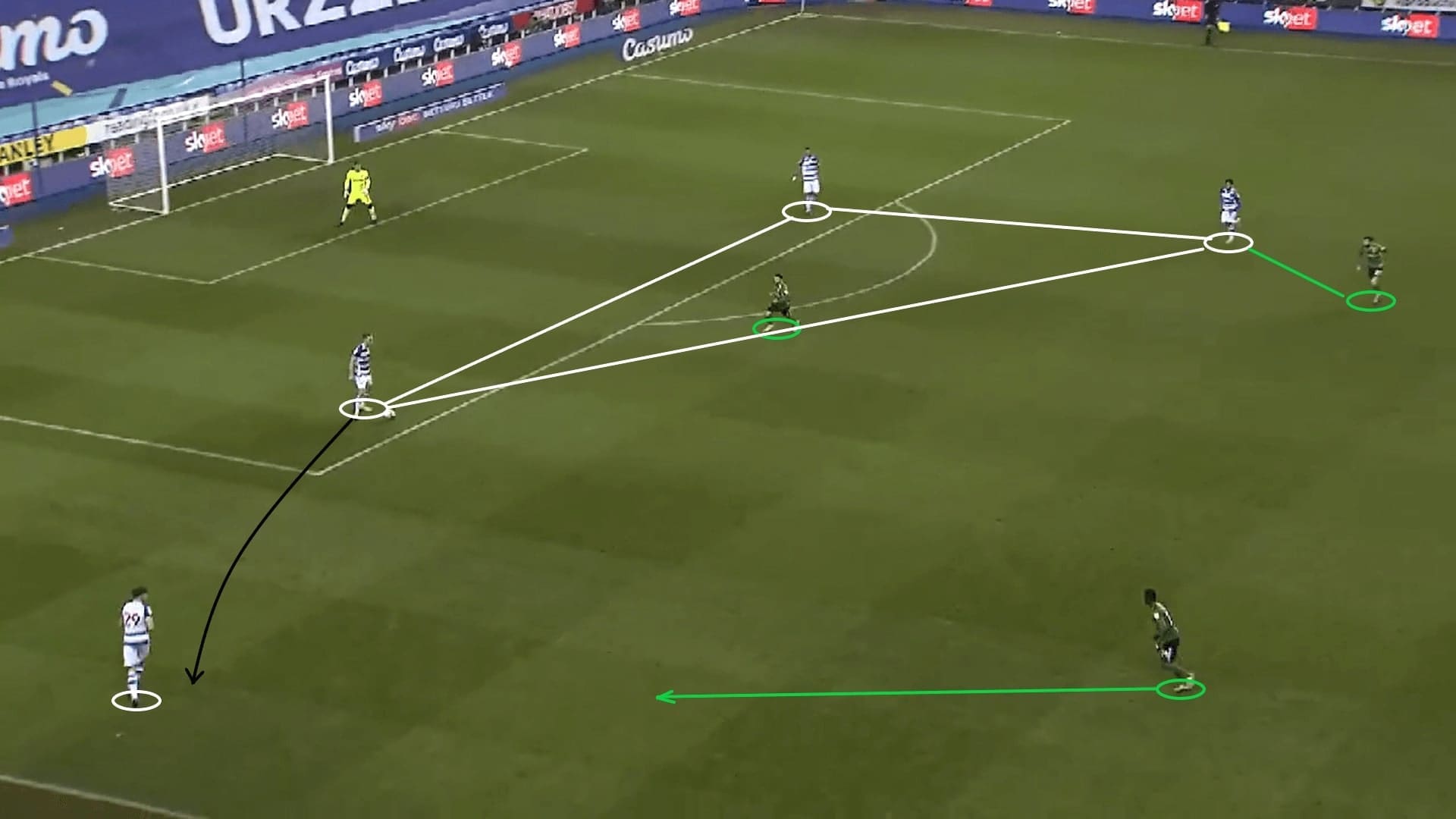
Karanka’s preferred shape has varied between a 4-2-3-1 and a 3-5-2, but the pressing concepts have been the same. When the ball was moved to the flanks, BCFC looked to trap it and kill all the options around by man-marking them tightly. In such a case, the offensive team would find it difficult to play out from the back with short passes. If they tried to bypass the press with long balls forward, the City defenders were expected to win the ball back in the air.
The tactic boards show the differences in Birmingham’s press – just a matter of spacing, direction, and timing. When defending in a back five, the wing-back was expected to mark the winger, so it was the wide midfielder’s job to press the full-back, while the strikers carried out their duties as explained. The drawback of this system was the large space for the midfielder to cover in order to access the wide full-backs, which gave the opponents more time to play the pass.
However, in a 4-2-3-1 or a 4-4-2, two wide players positioned themselves initially on the flanks, so the distance was shorter while both full-backs and wingers were under control. The midfielder was still tasked with man-marking a counterpart on his side, and those areas would be more congested than when playing in a back five system. Therefore, Karanka played his team in a back four more often (43%) compared to a 3-5-2 (18%).
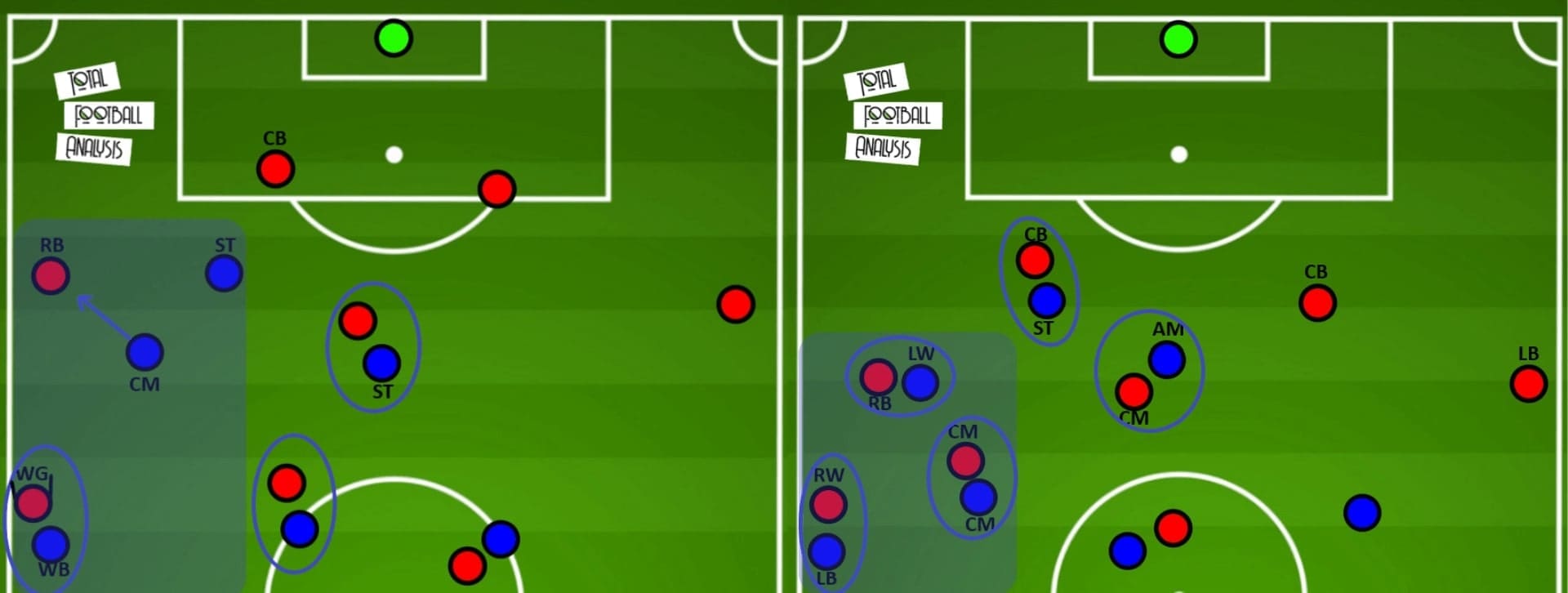
The pressing was very predictable as rules were simple. Sometimes it might not work well when facing teams which interchange positions a lot in the offensive phase. For example, when Reading FC pushed the left-back high and dropped the midfielders, the BCFC winger would be confused as to who to mark. For example, Iván Sánchez did not know what to do in this case.
Another issue was the defensive awareness of the first layer. The strikers tended to pay attention to the centre-backs, but left the pivot free as the play developed. This meant that the opposition pivot could be free to receive the ball in the build-up.
This image shows the situation – the spaces between the first and second layer were too large, while the midfielders were never aggressive enough to cover those areas behind the strikers. Due to losing vertical compactness, this poor spacing was exploited by the opposition and the press collapsed.
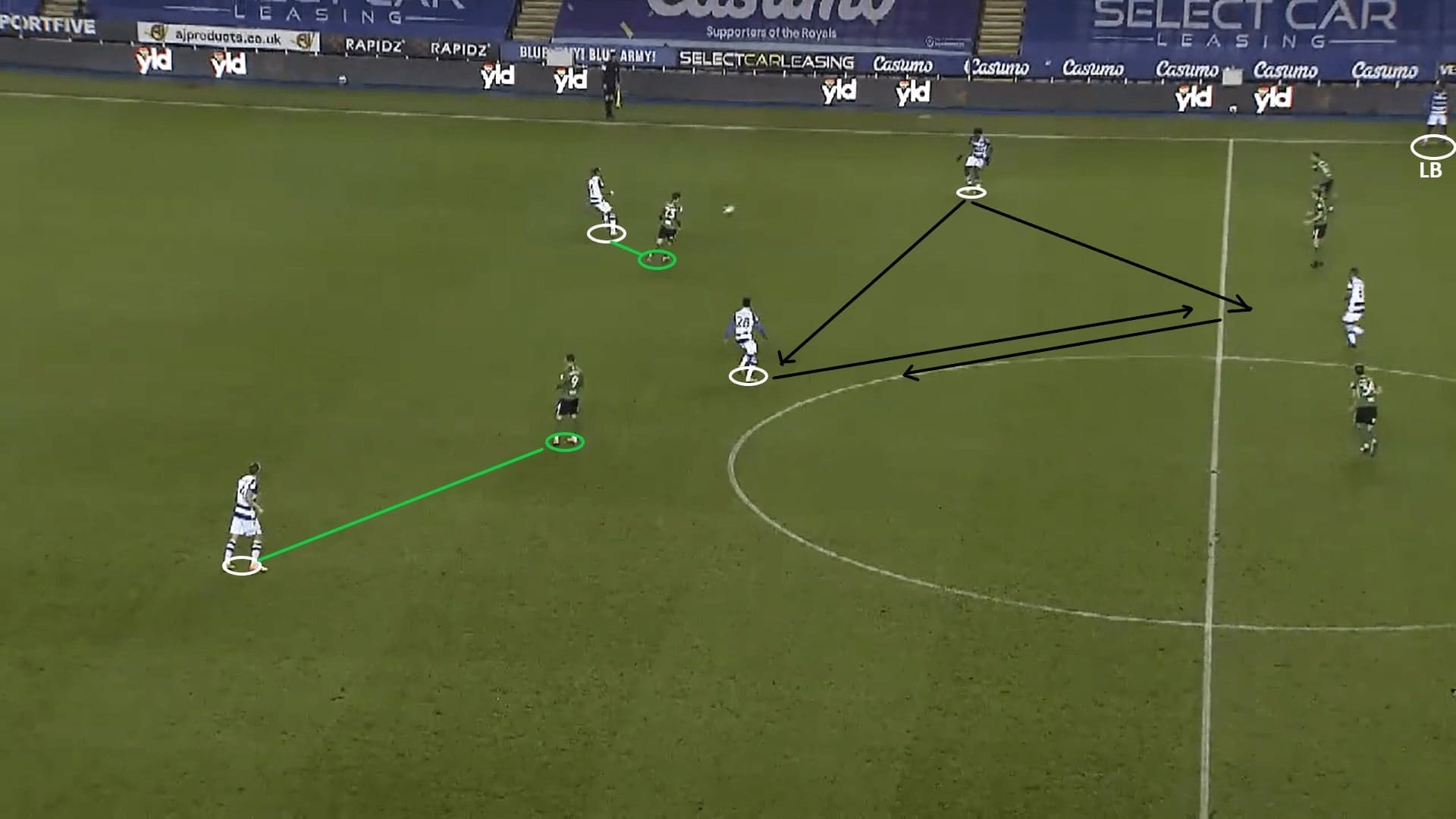
Even in situations where they had numerical equality or superiority on the flanks, sometimes BCFC failed to recover possession in man-oriented situations without pressing the closed bodies. Here, they had a 3 v 2 benefit in the area highlighted in blue, but the higher player did not press from the blindside or block the return pass. Instead, he stood still and allowed the backward pass.
Then, often following the return pass was a switch. The opponent would take advantage of the weak side of the press and develop the attack there. Note how large the yellow zone is – Watford went this way as BCFC committed the press on the other side.
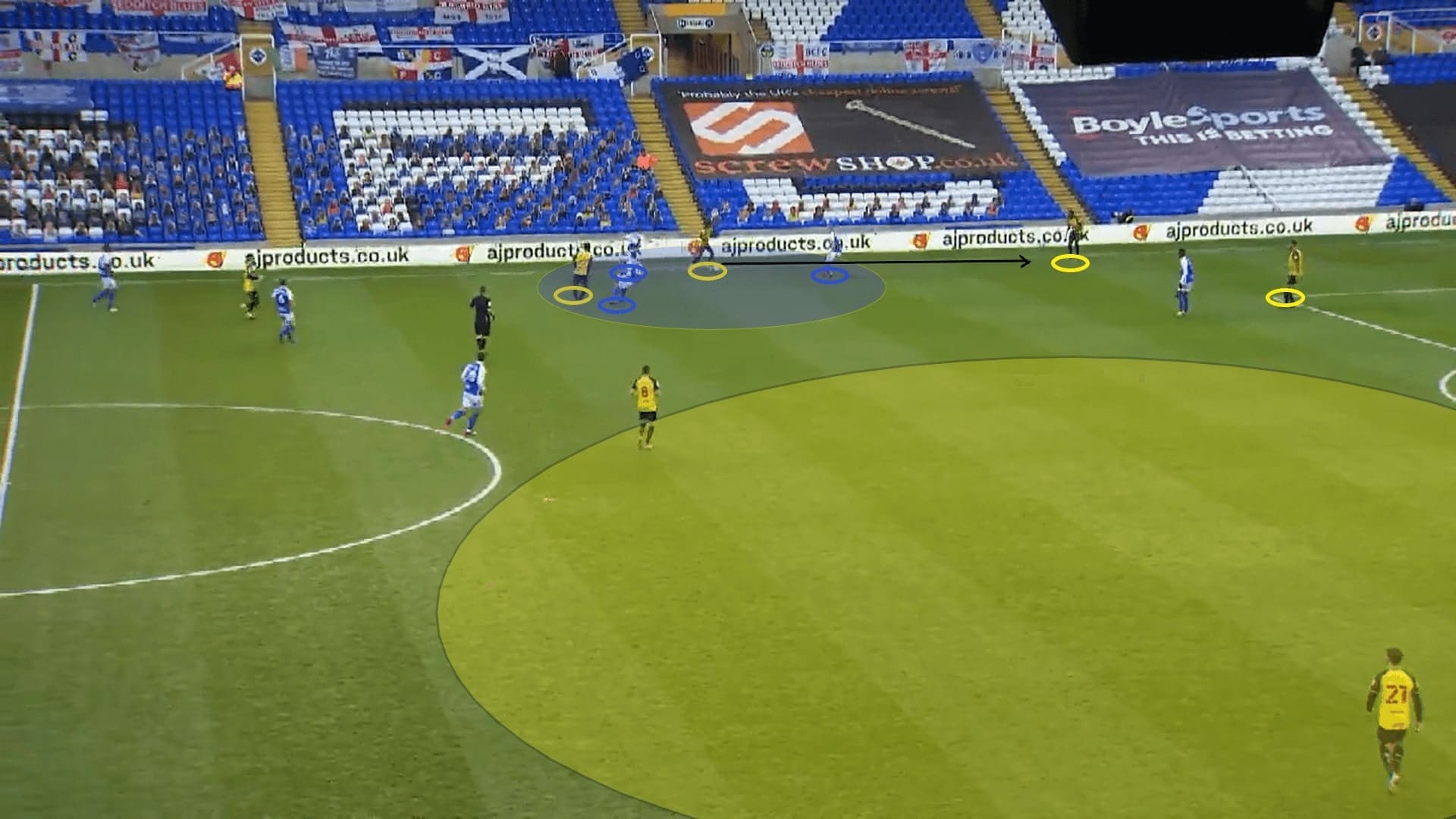
Spacing behind the backline leading to crosses
Despite the pros and cons of the press being very clearly explained, this was not the worst part of Birmingham’s defending as they still had enough numbers to defend at the back. The real problems were seen in the remaining parts of the piece, mostly occurring in the low block, which can be attributed to player traits, behaviour and errors.
One particular recurring issue was the spacing behind the backline. BCFC were weak at defending through balls. The opposition often found themselves in zone 16 or 18, and crossed into the penalty box to create an opportunity.
There are some factors leading to this issue – suboptimal body orientations of the wide defenders being one of them. The wing-back in this case was shaken off-balance by the double-movement of the winger, and hence was unable to chase or cover spaces behind.
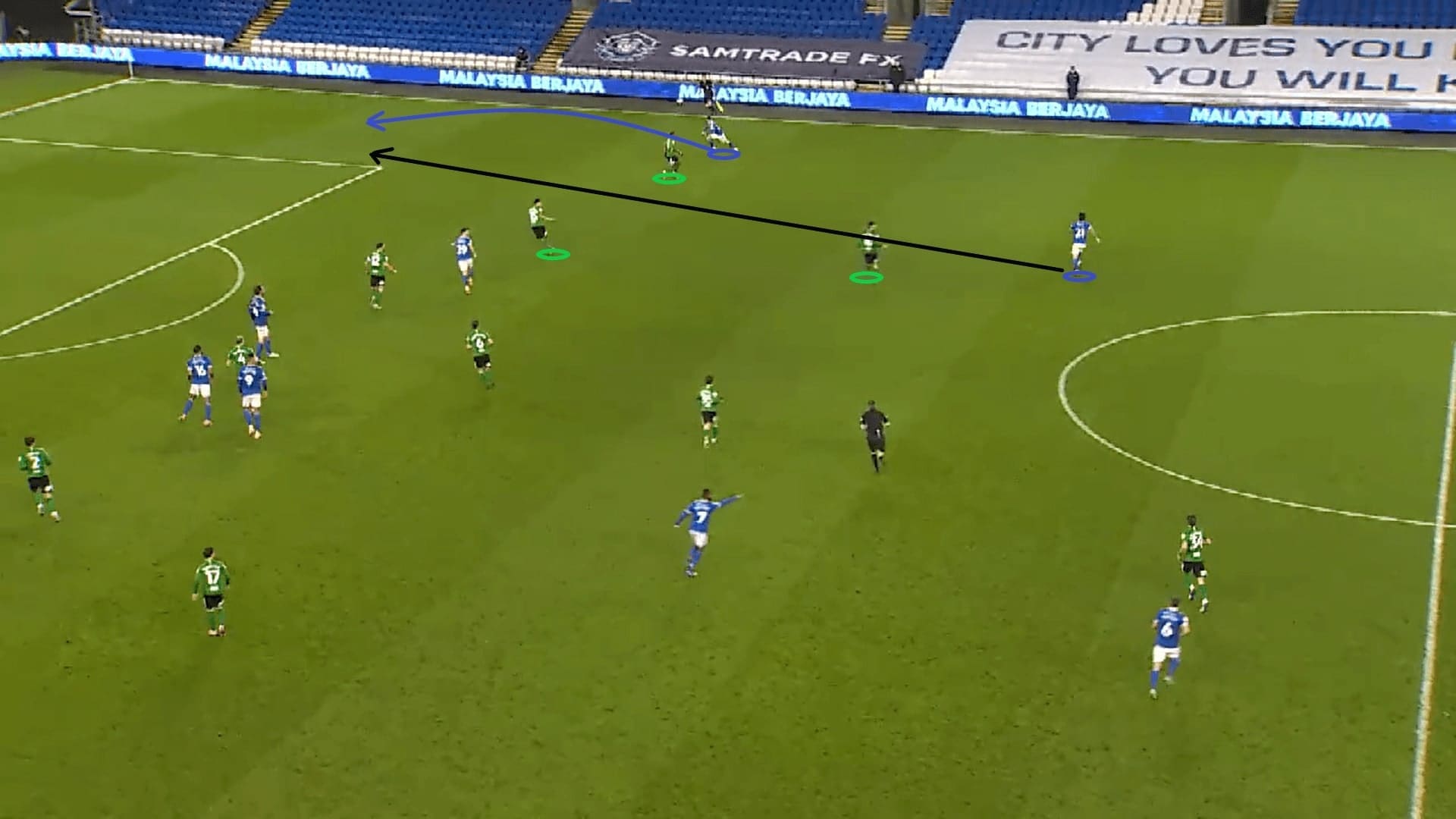
Another part of the reason was the lack of support from teammates. In fact, BCFC had a 3 v 2 on the flanks to defend this attack. However, none of the players in the half-spaces tried to help. If the midfielder pressed the ball before the releasing pass, the quality of the delivery could be worsened; and if the defender in the half-spaces provided cover, then the receiver would not be able to score in the 1 v 1 against Etheridge.
There are a few more issues related to this: the concentration level of the players. Sometimes the defenders were caught ball-watching, and no one tracked the runners. Here, David Brooks simply released the runner behind the defence and BCFC could merely react.
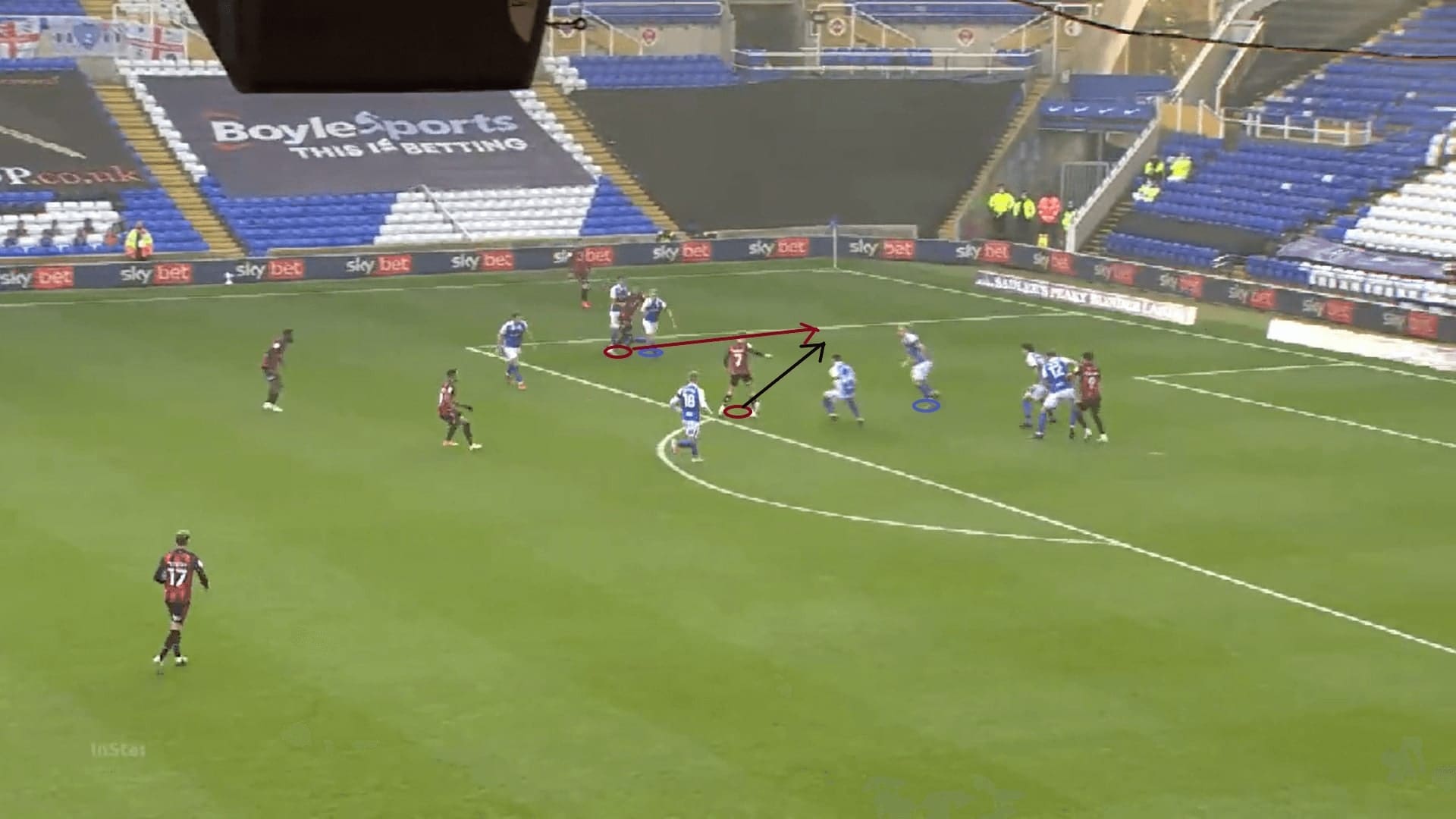
Another example which led to a goal being conceded in the Bournemouth game. The centre-back – Marc Roberts left the backline to press the ball. This was a commonly seen behaviour from the defenders, but what they did badly was the defending of half-spaces.
This image shows the right wing-back orienting his body in a suboptimal manner. He was not ready to turn quickly to chase the runner. Combined with the open half-spaces channel, Bournemouth easily penetrated into the penalty box and scored.
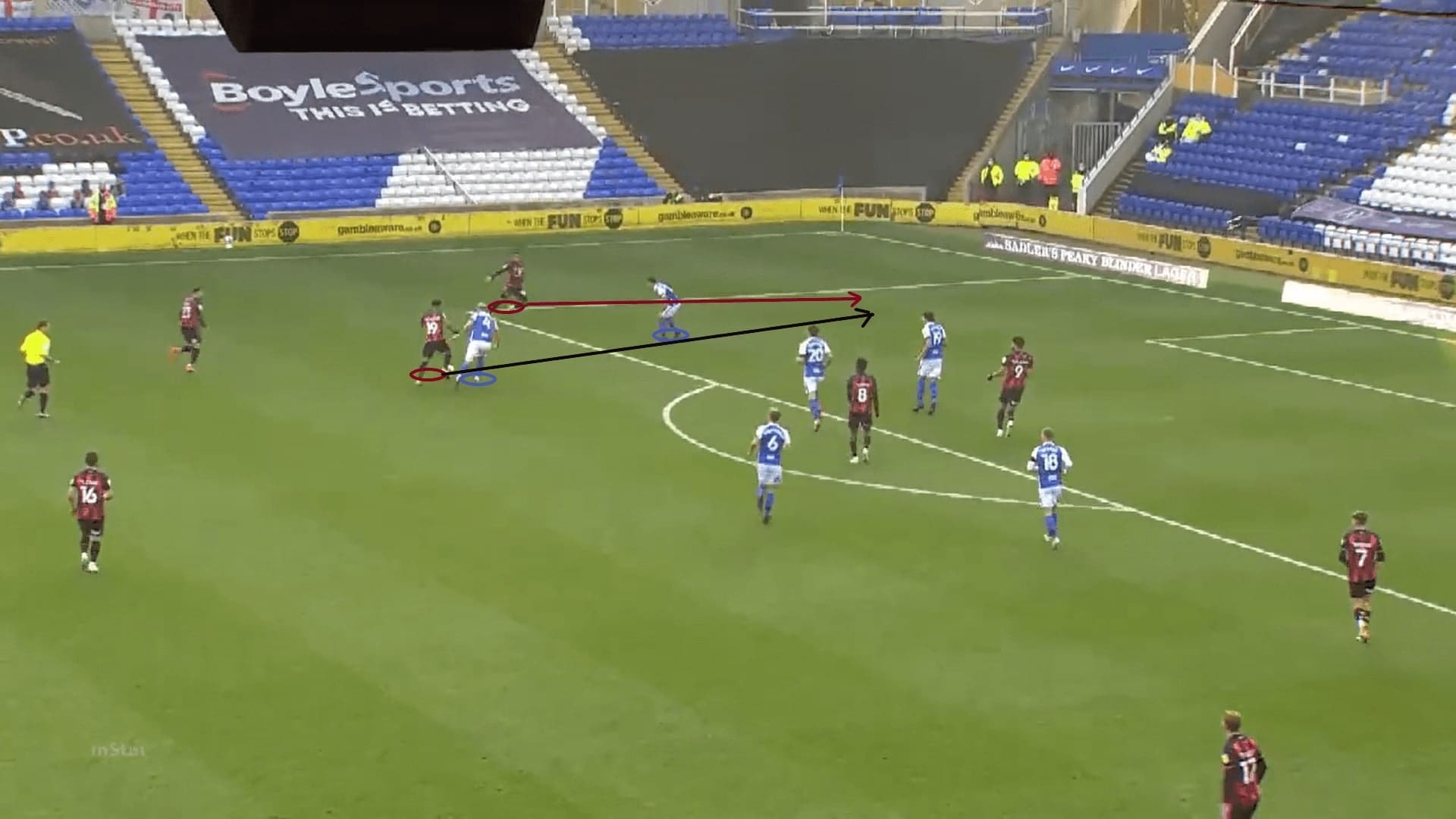
The weak protection of space behind the defence also happened as a result of defending long balls and counter-attacks poorly. In both cases, the BCFC midfield was not covering the backline enough, leaving it exposed against the opposition. This scenario was moments before the penalty conceded against Watford, which was a huge blow as they played really well in that game.
It was notable that the centre-back once again stepped up to press the opponent behind the midfield, but the left-back wrongly oriented himself towards the ball and neglected the outside runner. Rarely did the centre-backs show enough aggression to win the ball back or stop a release pass when stepping up. Defending these conditions effectively would be pivotal to avoid conceding clear-cut chances.
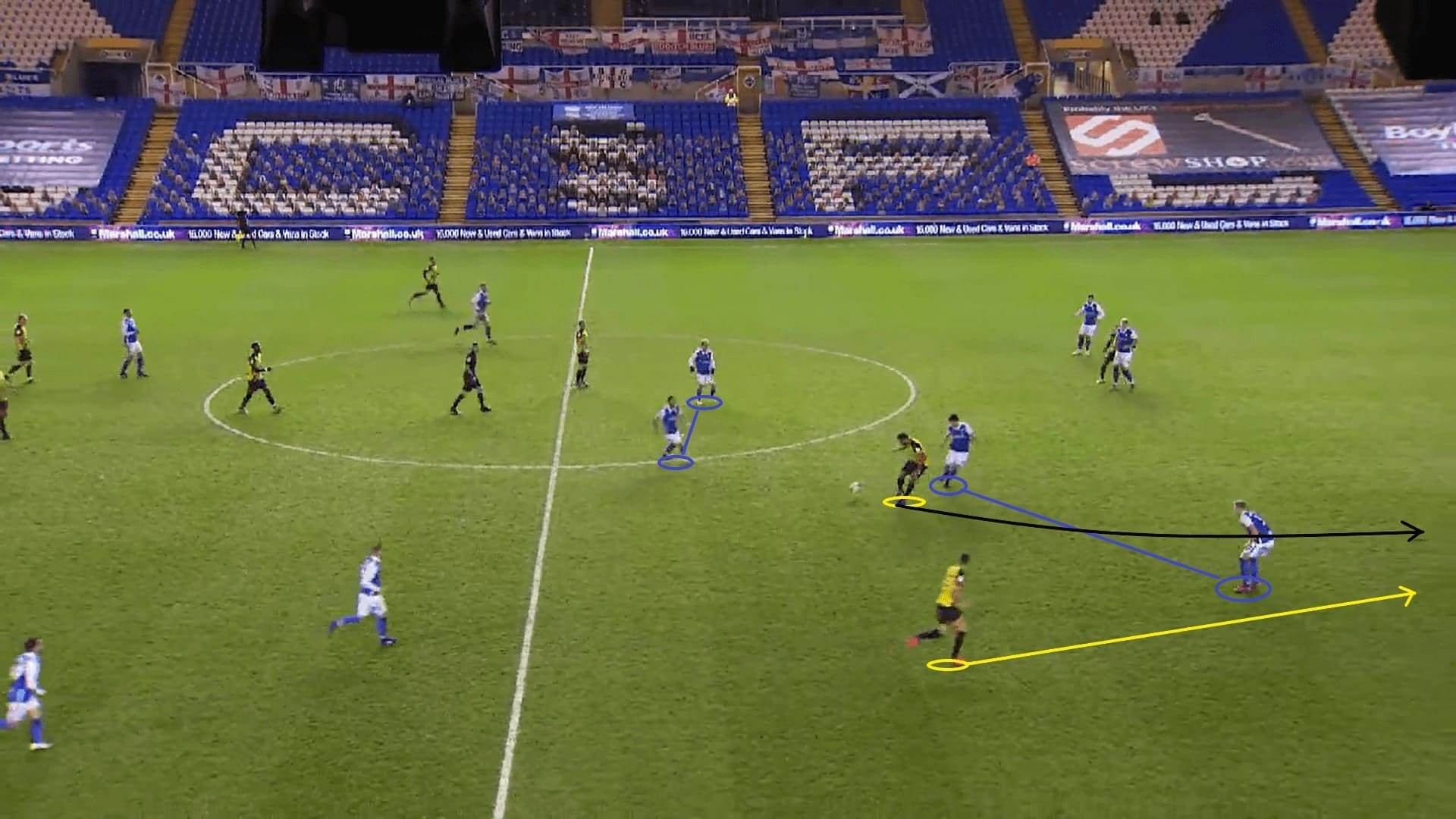
Inadequate midfield protection and isolations
Conceding crosses is not dangerous in itself, but it can be costly if the team fails to defend them effectively. In terms of the coverage of midfield, it was not enough, and BCFC conceded huge chances (xG>0.2) and goals because of this.
They have defenders who are good enough to defend balls in the air, and the backline had a good collective habit of retreating towards the six-yard box to prepare for the deep deliveries. However, this also means spaces around the penalty spot remained open and required coverage.
The City midfield should do more in these situations. Very often we saw that the backline moved deep but the midfielders did not follow. When the opponents cut the ball back, Karanka’s men would not be able to prevent shots from those areas. For example, this goal conceded against Norwich was a result of lacking midfield protection. Look at the position of the midfield when the cross was delivered, it was too far away from the attacking players, especially at the spaces around the penalty spot.
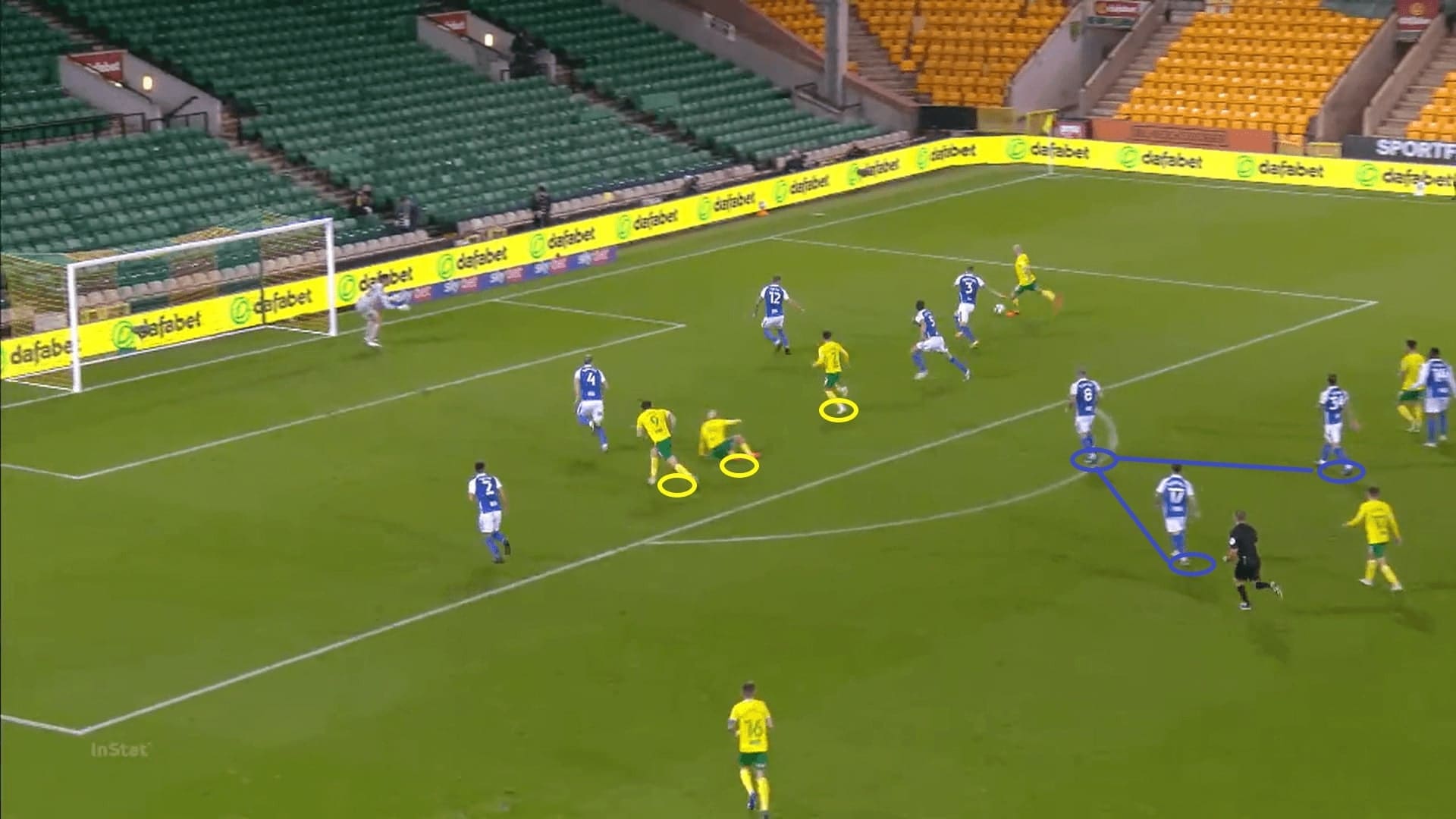
Their goal conceded against Stoke City earlier this season was a result of the weaknesses mentioned in these two sections. The light pressure on the ball when defending in a deeper block always allowed a good through pass to be played.
In the first image, the Stoke player easily played the pass and released the runner behind the wide defender, who was caught out of position.
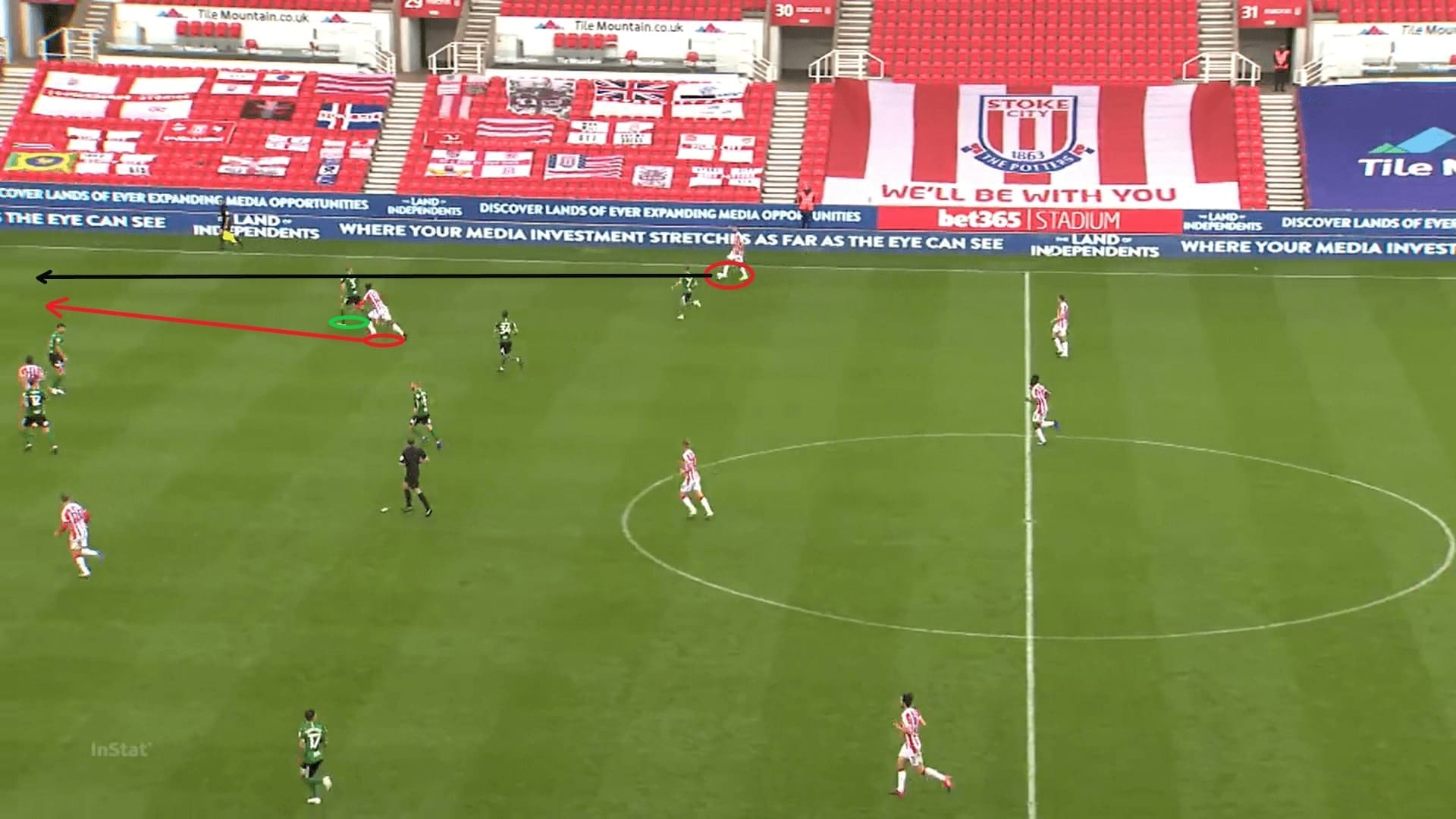
And very quickly, Stoke were in zone 18 and ready for a cross. This was not a big issue itself if BCFC could clear it. However, this was where the problem came in.
Firstly, the backline dropped deeper towards the six-yard box with suboptimal body shapes – orienting to the byline and leaving the blindside for the opponents. Secondly, the midfield line was far from the defenders, none of the midfielders showed sufficient defensive awareness to anticipate the potential dangers and opened spaces at the penalty spot.
Here comes the recurring pattern: through ball – cut-back – shot – goal. The BCFC defenders were not able to defend the cross if they were going back towards the penalty spot.
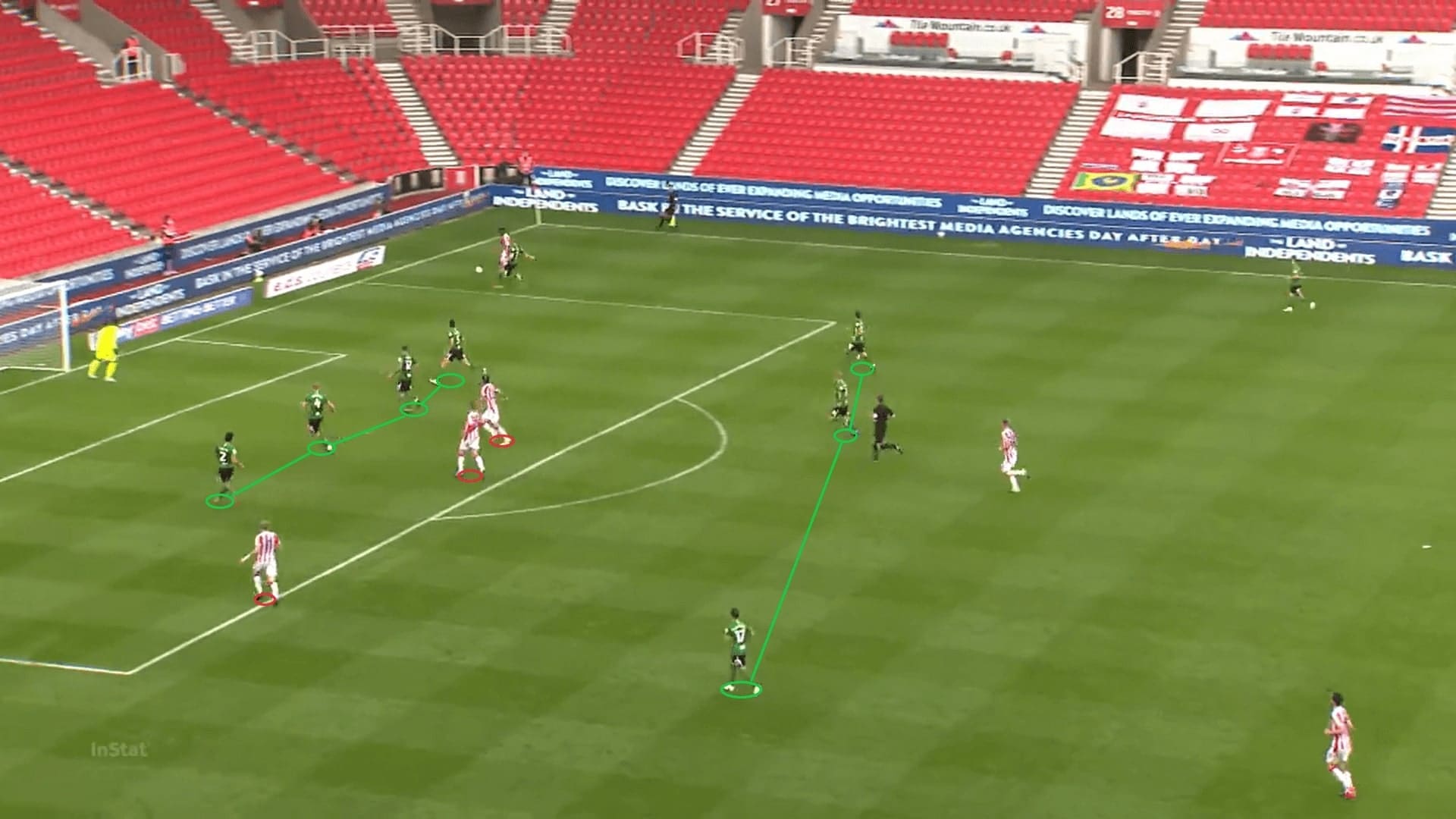
As the subtitle suggests, insufficient midfield protection also led to defenders being isolated, as the above examples have shown. Considering the above cases might be due to tactical reasons, we also include this goal to further investigate whether the issue was purely tactical or not.
Here, the BCFC defender was isolated in a 1 v 1 situation, while the half-spaces were opened once again as highlighted in red. The ball-carrier simply dribbled inward and shot with his weaker foot given the large spaces available which resulted in a goal.
And, what if the midfielders did better in this case? For example, Riley McGree could aggressively attack the blindside of the dribbler to help his teammates. Or, the player at the edge of the box could be more alert to cover the red spaces. In reality he was too late to do so. Is this passive defensive behaviour by instruction from Karanka, or the players’ poor performance? Only those on the inside will know the answer to this.
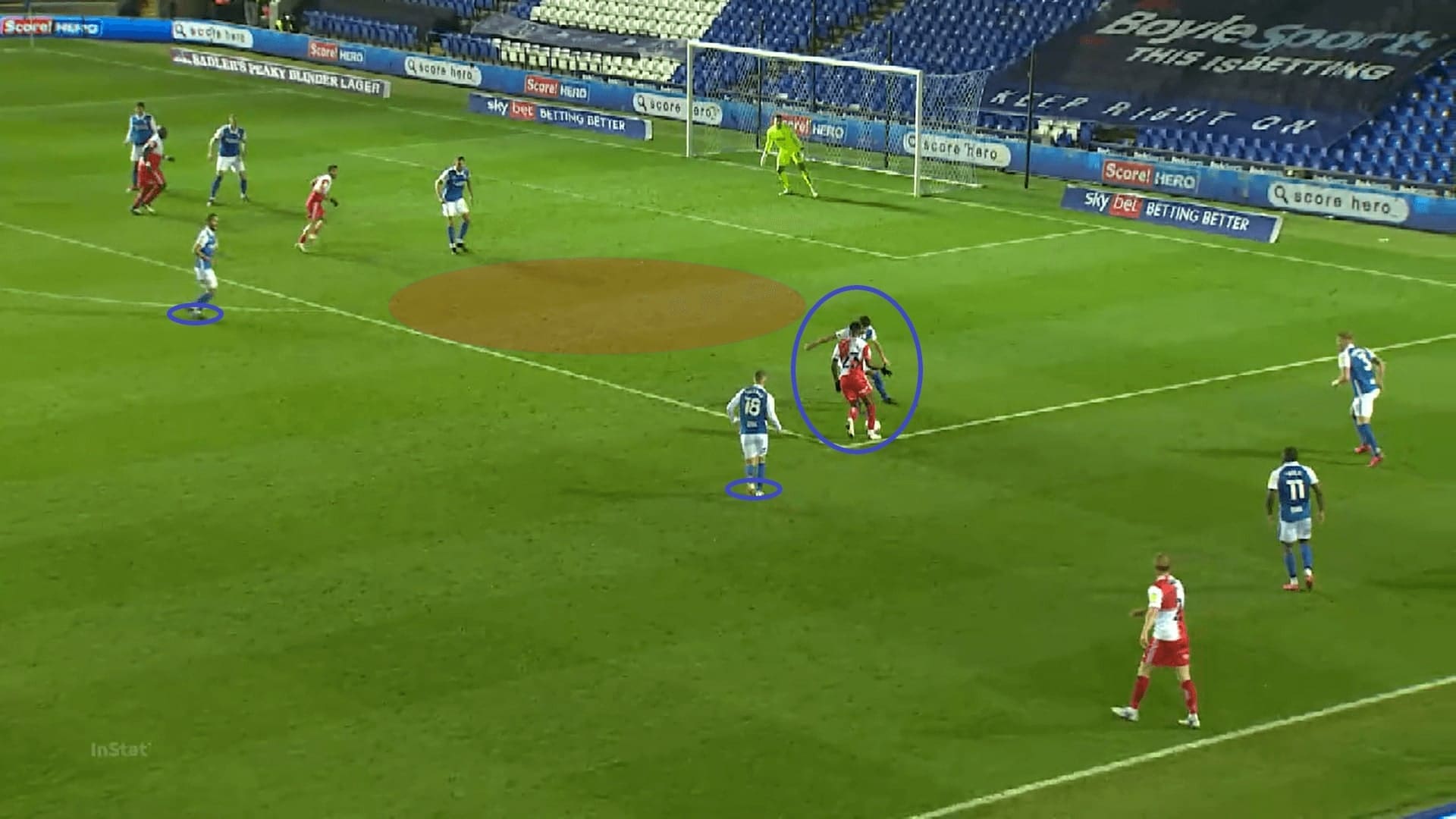
Final remarks
As shown in this team scout report, BCFC have been in trouble due to their issues when out of possession. These issues have happened more often as the season went on, and some new issues have also cropped up, such as their man-marking scheme at defensive set-plays – Birmingham City conceded a few goals from corners and indirect free-kicks recently, which was not seen as much during the start of the season.
Karanka and his coaching staff must find the solution as soon as possible to rectify these bad habits, or else the team might be in for a long relegation battle for the rest of the season.





Comments